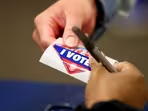The Downfall of O.J. Simpson: How His Murder Trial Changed Everything
Technically O.J. Simpson's life story took a turn for the irreparably tragic in the fleeting moments it took Nicole Brown Simpson and Ronald Goldman to die of the fatal knife wounds they suffered on the night of June 12, 1994.
But it was O.J.'s behavior over the next five days, regardless of how the legal proceedings dubbed the "Trial of the Century" ultimately turned out, that forever cemented his legacy as a fallen hero. Though it also wasn't long before the world knew that he was never the hero his adoring fans thought he was.
And while it's been almost 30 years since the murders, and more than 28 since O.J. was found not guilty of both, the case has never rested. It's unclear whether O.J.'s death from cancer at the age of 76 on April 10 will put a stop to the revisiting—but obviously the fascination will be prolonged for the time being as his story is retold from all angles.
As it re-unfolded on the Emmy-winning 2016 series American Crime Story: The People v. O.J. Simpson, and then in the Oscar-winning documentary O.J.: Made in America, those who were close to the NFL star turned broadcaster, beloved pitchman and B-movie actor known as "Juice" were apparently divided into three camps: Those who worshiped him, those who knew about his shortcomings as a human being, and those who did the former regardless of the latter.
PHOTOS: American Crime Story: The People v. O.J. Simpson Fact v. Fiction
O.J. was a national championship-winning, Heisman Trophy-caliber football star at USC and he went No. 1 in what was then the AFL-NFL draft to the Buffalo Bills in 1969. His Hall of Fame career included racking up 2,003 yards in 1973 (he's still one of only seven NFL players to ever rush for more than 2,000 yards in a season), six Pro Bowl selections and being central to the team's "Electric Company" offense.
Because he gave them the Juice, you know?
He never played in a Super Bowl, though ironically a Super Bowl-size audience ultimately tuned in for his downfall, which played out in the media nearly 24/7 about 15 years after he retired.
While he was still playing football O.J. became a Hollywood star as well, appearing in the seminal 1977 TV miniseries Roots, the big-screen disaster epic The Towering Inferno and the 1974 drama The Klansman.
He became a sought-after pitchman, stumping for Chevrolet and Royal Crown Cola. He was still the most famous face of Hertz rental cars until the day he was arrested for murder, having caught a red-eye flight to Chicago the night of the killings in order to play in a sponsored golf tournament the following day.
PHOTOS: The craziest quotes from The People v. O.J. Simpson
And those who never saw the esteemed running back rush for one yard knew him as the hapless Nordberg from The Naked Gun trilogy, a man of few words and many pratfalls. But either way, all of the O.J. achievements and appearances combined over the years made for one very famous guy in 1994.
In 1985, meanwhile, he married his second wife, Nicole Brown Simpson, whom he had met when she was 18 and he was 29, and they had two children together, Sydney and Justin.
The kids were asleep upstairs in Nicole's Brentwood condo when she and Ron were killed inside her front gate.
When the news broke in the early hours of June 13, 1995, that Nicole had been murdered, the media ultimately sprang to life with recollections of O.J.'s abusive behavior—which was strangely common knowledge and yet...
According to Jeffrey Toobin's 1996 account of the Simpson case, The Run of His Life (the source material for The People v. O.J. Simpson), on 3:58 a.m. on New Year's Day, 1989, Nicole called 911. When police arrived, her face was battered, she had a handprint on her neck and she had been hiding in the bushes outside in a bra and sweatpants. O.J. denied beating her and, when police asked O.J. to come down to the station, he drove off in his Bentley. Ultimately, Nicole was reluctant to press charges, but she signed the police report and O.J.—who would later suggest that Nicole had often been violent with him but he continued to love her "too much"—was prosecuted for misdemeanor battery.
It wasn't that any of it was swept under the rug—rather, it was more or less ignored by the media, let alone barely prosecuted. When deciding whether to bring charges, LAPD Officer Mike Farrell asked around to see if any cops remembered other incidents at the Simpson house. Only one, Mark Fuhrman (whose career as a detective would pretty much end after the O.J. trial), would offer an account about being called out there in 1985, but the cops actually went out there eight times before New Year's 1989.
The Simpsons divorced in 1992. When police notified Nicole's parents of her death via telephone two years later, her older sister Denise Brown was on the line and screamed, "He killed her! He finally killed her!"
After O.J. became the chief suspect in the murders due to forensic and circumstantial evidence, by all accounts he became consumed with his fate and legacy, rather than concerned with how his kids were doing or expressing any interest in finding out who really killed his ex-wife and her friend.
By the time he fled Robert Kardashian's house in a white Bronco with his friend Al Cowlings behind the wheel on June 17, 1994, and engaged police in a low-speed chase that would preempt coverage of the NBA Finals at one point, so many shocking things had already occurred. From O.J. signing a purported suicide note with a happy face in the "O" to the LAPD's only pre-arrest interview with the eventual suspect lasting a mere 32 minutes, the script was writing itself.
And that's why people remained obsessed about the O.J. case. It had all the makings of a Hollywood thriller: a couple of young, beautiful victims; a gruesome crime; a massive ensemble cast; and a hero turned villain whom not everyone believed to be guilty and who split a city right down the middle.
Two years before O.J. was arrested, four white LAPD officers were found not guilty of assaulting Rodney King, a Black taxi driver who was pulled over during a traffic stop in March 1991 and beaten within an inch of his life. Riots broke out in South Central Los Angeles in response to the verdict, which confirmed just how toxic the relationship had become between L.A. law enforcement and the city's Black community. More than 50 people died and 2,000 were injured over six days of rioting and looting. Police Chief Daryl Gates resigned a few months later.
On the flip side of that dysfunction was O.J.'s relationship with the police. He was friendly with the LAPD, even entertaining officers at pool parties at his house on occasion.
Though O.J. himself had insisted "I'm not black, I'm O.J." (in a 1967 New York Times interview, not after the murders), his attorneys—the "Dream Team," led by charismatic civil rights activist Johnnie Cochran—ultimately made the case about race. They insisted the LAPD actually had it in for Simpson, rather than enjoyed a friendly relationship that resulted in nine visits to his house to investigate domestic disturbances and exactly one misdemeanor prosecution.
The O.J. trial wasn't Court TV's first rodeo, but it set a new precedent for just how much coverage and gory details and interviews and opinions the public would eat up with a spoon. So it turned out, the public's appetite was insatiable.
A jury of 10 women and two men were seated in November 2014. Opening statements began Jan. 24, 1995, the prosecutors lost their grip on what they surely considered at the very beginning to be an open-and-shut case, and on Oct. 3, 1995, O.J. Simpson was found not guilty of the murders of Nicole Brown Simpson and Ronald Goldman.
Presumably because there was no justice in the real case of The People of the State of California v. Orenthal James Simpson, the fact that O.J. was sentenced in December 2008 to 33 years in prison in Nevada—for armed robbery, kidnapping and other offenses for his role in a heist to get back what he maintained was stolen memorabilia—became practically a blip on the pop culture radar. (He was paroled in 2017 and granted early release from parole in 2021.)
Because what happened in 1994—when millions of TV sets were tuned to the low-speed Bronco chase and then more or less stayed on for a year and a half of courtroom drama—never happened again. Or at least not in quite the same way. (Gwyneth Paltrow's ski trial and Depp vs. Heard of course had their moments.)
The Kardashians weren't a thing yet (Robert Kardashian's involvement and Kris Jenner's friendship with Nicole aside). You couldn't Google stories about O.J.'s messy divorce. There was no social media and most cell phones were clipped to people's belts, next to their beepers.
All people could do was watch it play out on TV, and because the likes of CNN and Court TV knew people were watching most hungrily, they gave the masses what they wanted. More.
But there was only so much to give at the time. And because we weren't yet on information overload in the mid-90s, no matter how much cable news tried to get us there in record time, there was still more to be discovered, analyzed, shocked by and regretted for years to come as O.J. played golf and went about his life.
The equivalent of what happened then would be [insert widely admired, charming guy whose past transgressions society has turned a blind eye to] going on trial for killing his ex-wife. And then you tweeted about nothing else for a year.
We agree, it's pretty much impossible to imagine.
But with O.J. Simpson there was obviously a before and an after. Read on to see his whole life in pictures:
Simpson was born in 1947 and started his football career at the City College of San Francisco. After playing for two seasons and being named a junior college All-American, Simpson transferred and started playing for the University of Southern California's Trojans in 1967.
The following year, he won the Heisman Trophy.
In addition to playing football, Simpson explored acting—including in the movie The Klansman. He later appeared in The Towering Inferno, Killer Force and The Cassandra Crossing.
Following his college football career, the running back entered the NFL and played for the Buffalo Bills from 1969 to 1977.
Simpson attended the Cannes Film Festival with producer Patrick Wachsberger in 1975.
Simpson was married to Marguerite Whitley from 1967 to 1979. Together, they welcomed three children: Arnelle, Jason and Aaren. Aaren died in a drowning accident in 1979.
The family is pictured at their home in 1975.
Following his near-decade with the Bills, the athlete joined the San Francisco 49ers, where he played for a two seasons before retiring from football.
Simpson pictured here posing with his Ferrari at Warner Bros Studios.
After playing the game, Simpson became a sports analyst. Here, he can be seen covering a game for NBC in 1980.
Simpson married Nicole Brown in 1985, the same year they welcomed their first child together, Sydney, and Simpson was inducted into the National Football Foundation and College Hall of Fame.
Here, the pair is pictured at an Oscars viewing party in 1983.
Simpson and Brown also welcomed a son, Justin, in 1988. However, the couple divorced four years later in 1992.
Here the family is pictured at the Naked Gun 33⅓: The Final Insult premiere in 1994—the same year that she was killed.
In June 1994, Simpson was accused of murdering Brown and her friend Ron Goldman. He took off in a white Bronco, and millions of people watched the televised police chase.
Simpson's 1994 mugshot after his arrest.
Simpson went to trial in 1995, and the case captured the nation. He pleaded not guilty and was acquitted on all counts.
He was found liable for Brown and Goldman's deaths in 1997 in a civil lawsuit filed by their families and was ordered to pay $33.5 million in damages, according to The New York Times.
Simpson would make headlines again when he penned the book If I Did It, with the Goldman family later successfully suing for the manuscript and adding the subhead Confessions of the Killer.
However, these wouldn't be Simpson's last trials. In 2008, he was found guilty of armed robbery, kidnapping and 10 additional charges that were in regard to a memorabilia robbery in Las Vegas, and he was sentenced to nine to 33 years in prison, per The New York Times. He served nine years in prison before he was released on parole.
Simpson speaking at a parole hearing.
(Originally published Feb. 9, 2016, at 11:16 a.m. PT)
Watch E! News weeknights Monday through Thursday at 11 p.m., only on E!.Disclaimer: The copyright of this article belongs to the original author. Reposting this article is solely for the purpose of information dissemination and does not constitute any investment advice. If there is any infringement, please contact us immediately. We will make corrections or deletions as necessary. Thank you.
Title:The Downfall of O.J. Simpson: How His Murder Trial Changed Everything
Url:https://www.investsfocus.com







